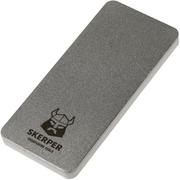Sharpening a lawn mower
Sharpening a lawnmower blade can be done just fine by yourself! Dull lawnmower blades tear grass instead of cutting it cleanly. This leads to ragged edges, an unhealthy lawn and increased risk of disease. By regularly sharpening the blade of your lawnmower, you will ensure a clean cut and a healthier lawn. Moreover, a properly sharpened mower consumes less energy or fuel.
What types of lawnmowers are there?
Depending on the type of mower, the way you sharpen the blades also differs:
- Sharpening a manual lawn mower (spindle mower)
This has multiple blades in a cylinder that rotate along a fixed lower blade. Here, accuracy is important: each knife must be just as sharp as the others.
- Sharpening an electric or petrol lawn mower
These usually have one horizontally rotating blade with two or four blades. You sharpen these with a whetstone or electric knife sharpener.
How do you sharpen a lawnmower blade?
Lawnmower blade sharpening is almost always done the same way. You sharpen the sharpened parts of lawnmower blades to make them straight and sharp again. Which abrasive to use may vary, though. Read more about which sharpening methods are best to use to sharpen your lawnmower blades here.
Step 1: safety first
Disconnect the power or battery or disconnect the spark plug lead on petrol mowers. Remove the blade from the mower. Note how it is mounted for correct retrofitting. In the case of a spindle mower, you lay the spindle mower flat on the ground and leave the blade attached. Wear gloves and goggles for extra safety.
Step 2: clean the blade
Remove grass clippings and dirt with a wire brush or cloth. A clean blade sharpens better and is better for your sharpening tools.
Step 3: choose your sharpening method
1. A sharpening stone: use a sharpening stone with a coarse to medium grit (around 300 to 600 grit) depending on the state of the knife. Use an extra coarse sharpening stone if you see damage in the blades. Move the stone over the cutting edge of the knife at a constant angle (usually around 30°). Make long, smooth strokes while keeping the sharpening angle as constant as possible. Then remove the burr on the other side with a few light strokes.
2. An electric sharpener: for those who want to work faster, an electric sharpener like the Work Sharp Ken Onion Edition is ideal. Use a medium or coarse band. This is especially useful for thicker blades or if you want to sharpen several lawnmower blades at once.
Step 4: check balance sheet
After sharpening, it is important to check your electric or petrol lawn mowers to make sure the blade is still balanced. An unbalanced blade can cause damage to the mower, but usually you don't take away that much material and the balance is still fine. However, should you experience extra vibration, make sure you sharpen the heavier side so that the blade is balanced again.
Step 5: reassemble the blade
Attach the blade securely and make sure it is positioned correctly so that your blade does not cut in the wrong direction or hit the housing.
How often should you sharpen a lawnmower?
For most users, 2-3 times a season is enough. Do you mow often or on uneven terrain with lots of twigs and stones? Then more frequent sharpening may be necessary. Check the blade for burrs or damage after you're done mowing the lawn.
Maintenance of lawnmower blades
A well-maintained blade stays sharp longer and works more efficiently.
- Clean the blades with a cloth or brush after each use
- Remove caked grass
- After cleaning, apply a thin layer of oil against rust
- Check screws and bolts regularly
































